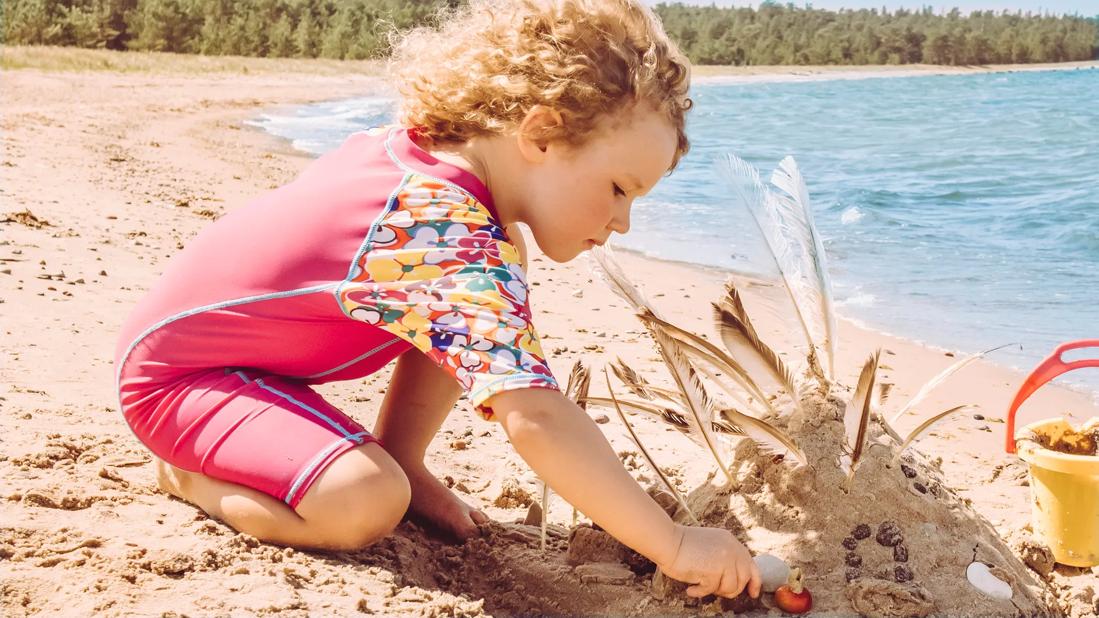Look for a UPF rating of 50+ for optimal protection against UV rays

The sun is shining — and you’ve got a full day planned at the pool, beach or park.
Advertisement
Cleveland Clinic is a non-profit academic medical center. Advertising on our site helps support our mission. We do not endorse non-Cleveland Clinic products or services. Policy
In addition to slathering on sunscreen, you can add an extra layer of security to your skin during outdoor adventures by wearing UV light protection clothing (also called UPF clothing or sun-protective clothing).
These items — from hats and shirts to leggings — block the sun’s harmful UV (ultraviolet) rays. And they can be a helpful way to steer clear of a painful sunburn and reduce sun damage and your skin cancer risk.
The term “UPF” stands for ultraviolet protection factor, says dermatologist Shilpi Khetarpal, MD. It gives you an idea of how much UV radiation a certain piece of clothing blocks from your skin.
UV light can penetrate through the micro holes in the weaves of regular clothes or even travel directly through a light-colored shirt. With UPF clothing, the block is much greater, giving you more protection from the sun.
“UPF clothing is made from a special fabric to help form a barrier against the sun’s rays,” explains Dr. Khetarpal.
Most UPF clothing looks and feels like activewear or athleisure. And because of the higher thread count, it often feels a little more luxurious vs. your standard T-shirt.
A UPF rating reflects how effective the fabric is at blocking UV rays. A higher UPF rating is better.
Advertisement
For example, 30 UPF means the item will allow 1/30th or 3.33% of UV rays to pass through.
“For example, most cotton shirts give you an equivalent of about a UPF of 5 when you’re wearing it,” Dr. Khetarpal notes. “Most fabrics that we wear are a loose weave that lets visible light peek through and get to our skin.”
Any garment that allows less than 2% of UV rays will be labeled UPF 50+, the highest rating. 15 UPF is the lowest rating. An item needs to have 50 UPF or higher to obtain the Skin Cancer Foundation’s seal of recommendation.
Here are some common UPF ratings you may see:
| UPF Rating | Protection | % UV Radiation Blocked |
|---|---|---|
| UPF 15 | Fair | 93% |
| UPF 30 | Good | 96.7% |
| UPF 50+ | Excellent | 98% |
| UPF Rating | ||
| UPF 15 | ||
| Protection | ||
| Fair | ||
| % UV Radiation Blocked | ||
| 93% | ||
| UPF 30 | ||
| Protection | ||
| Good | ||
| % UV Radiation Blocked | ||
| 96.7% | ||
| UPF 50+ | ||
| Protection | ||
| Excellent | ||
| % UV Radiation Blocked | ||
| 98% |
Over time, the effectiveness of UPF clothing could change based on factors such as:
Beyond making sure your clothing has UPF, here are a few other considerations:
Anyone — kids and adults alike — can use UPF clothing. Consider wearing UPF clothing, especially if you’re:
A shirt, pants and hat can give you great sun protection coverage, but that still leaves areas like your hands, neck and face exposed to UV rays. This is where sunscreen still comes into play and can help prevent sunburn and skin cancer.
“Most sun-protected fabrics are UPF 50 or higher ― so better than your typical SPF sunscreen,” says Dr. Khetarpal. “But it’s recommended for people to choose a mix of both sunscreen and clothing to get the best possible protection.”
Advertisement
Learn more about our editorial process.
Advertisement

A sunburn will leave you itchy and red, while sun poisoning can feel like an allergic reaction

A cool shower, aloe vera gel, anti-itch treatments and cool compresses can provide fast sunburn relief

SPF stands for ‘sun protection factor’ — it’s a measure of how much protection you’re getting before a sunburn is possible

This ‘poisoning’ is actually a severe sunburn that seems similar to an allergic reaction

When outside, protect your skin from damaging UV rays with a fresh layer of sunscreen at least once every two hours

Chemicals, fragrances and other ingredients in sunscreen can cause allergic reactions or irritate your skin

Both can protect you from the sun’s rays, but they do it in different ways

Your skin tone determines if a sunburn becomes a suntan

If you’re feeling short of breath, sleep can be tough — propping yourself up or sleeping on your side may help

If you fear the unknown or find yourself needing reassurance often, you may identify with this attachment style

If you’re looking to boost your gut health, it’s better to get fiber from whole foods